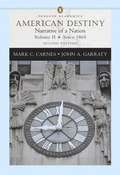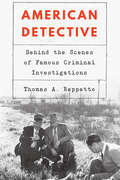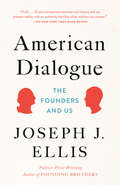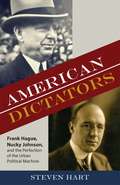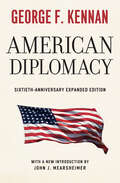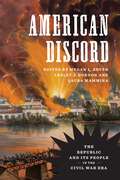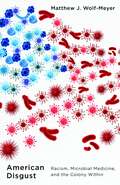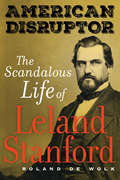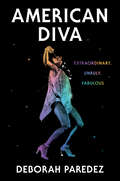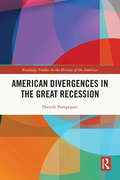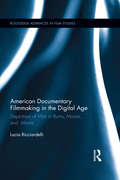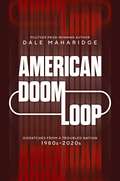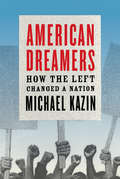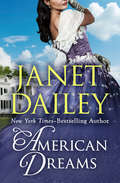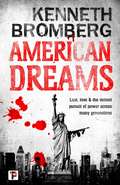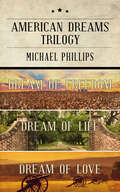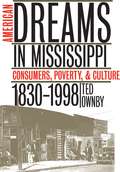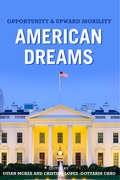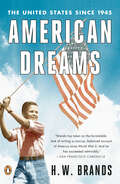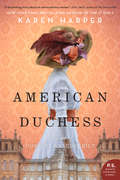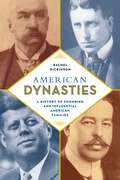- Table View
- List View
American Destiny: Since 1865 (2nd edition)
by Mark C. Carnes John A. GarratyDrawing on a political historical framework, this text examines the political, social, economic, and cultural developments that have shaped the United States. Carnes (history, Barnard College) and Garraty (history, emeritus, Columbia University) begin the story with the crossing of the Bering Strait and cover events as recent as the attack on the World Trade Center and subsequent "War on Terror." Annotation (c)2003 Book News, Inc., Portland, OR (booknews.com)
American Detective: Behind the Scenes of Famous Criminal Investigations
by Thomas A. ReppettoFrom the Roaring Twenties to the 1970s detectives reigned supreme in police departments across the country. In this tightly woven slice of true crime reportage, Thomas A. Reppetto offers a behind-the-scenes look into some of the most notable investigations to occur during the golden age of the detective in American criminal justice. From William Burns, who during his heyday was known as America’s Sherlock Holmes, to Thad Brown, who probed the notorious Black Dahlia murder in Los Angeles, to Elliott Ness, who cleaned up the Cleveland police but failed to capture the “Mad Butcher” who decapitated at least a dozen victims, American Detective offers an indelible portrait of the famous sleuths and investigators who played a major role in cracking some of the most notorious criminal cases in U.S. history. Along the way Reppetto takes us deep inside the detective bureaus that were once the nerve centers behind crime-fighting on the streets of America’s great cities, including the FBI itself, under the direction of America’s “top cop,” J. Edgar Hoover. According to Reppetto, detectives were once able watchdogs until their role in policing became diluted by patrol strategies ranging from “stop and frisk” to community policing. Reppetto argues against these current policing systems and calls for a return to the primacy of the detective in criminal investigations.
American Dialogue: The Founders and Us
by Joseph J. EllisThe award-winning author of Founding Brothers and The Quartet now gives us a deeply insightful examination of the relevance of the views of George Washington, Thomas Jefferson, James Madison, and John Adams to some of the most divisive issues in America today. <p><p> The story of history is a ceaseless conversation between past and present, and in American Dialogue Joseph J. Ellis focuses the conversation on the often-asked question "What would the Founding Fathers think?" He examines four of our most seminal historical figures through the prism of particular topics, using the perspective of the present to shed light on their views and, in turn, to make clear how their now centuries-old ideas illuminate the disturbing impasse of today's political conflicts. He discusses Jefferson and the issue of racism, Adams and the specter of economic inequality, Washington and American imperialism, Madison and the doctrine of original intent. Through these juxtapositions--and in his hallmark dramatic and compelling narrative voice--Ellis illuminates the obstacles and pitfalls paralyzing contemporary discussions of these fundamentally important issues.
American Dictators: Frank Hague, Nucky Johnson, and the Perfection of the Urban Political Machine (Rivergate Regionals Collection)
by Steven HartAmerican Dictators is the dual biography of two of America's greatest political bosses: Frank Hague and Enoch "Nucky" Johnson. The book shows Hague and Johnson at the peak of their power and the strength of their political machines during the years of Prohibition and the Great Depression. Steven Hart describes how both men used their influence to benefit and punish the local citizenry, amass huge personal fortunes, and sometimes collaborate to trounce their enemies.
American Diplomacy: Sixtieth-anniversary Expanded Edition (Walgreen Foundation Lectures)
by George F. KennanFor more than sixty years, George F. Kennan’s American Diplomacy has been a standard work on American foreign policy. Drawing on his considerable diplomatic experience and expertise, Kennan offers an overview and critique of the foreign policy of an emerging great power whose claims to rightness often spill over into self-righteousness, whose ambitions conflict with power realities, whose judgmentalism precludes the interests of other states, and whose domestic politics frequently prevent prudent policies and result in overstretch. Keenly aware of the dangers of military intervention and the negative effects of domestic politics on foreign policy, Kennan identifies troubling inconsistencies in the areas between actions and ideals—even when the strategies in question turned out to be decided successes. In this expanded sixtieth-anniversary edition, a substantial new introduction by John J. Mearsheimer, one of America’s leading political realists, provides new understandings of Kennan’s work and explores its continued resonance. As America grapples with its new role as one power among many—rather than as the “indispensable nation” that sees “further into the future”—Kennan’s perceptive analysis of the past is all the more relevant. Today, as then, the pressing issue of how to wield power with prudence and responsibility remains, and Kennan’s cautions about the cost of hubris are still timely. Refreshingly candid, American Diplomacy cuts to the heart of policy issues that continue to be hotly debated today. “These celebrated lectures, delivered at the University of Chicago in 1950, were for many years the most widely read account of American diplomacy in the first half of the twentieth century.”—Foreign Affairs, Significant Books of the Last 75 Years
American Discord: The Republic and Its People in the Civil War Era
by John F. Marszalek Lawrence A. Kreiser Jr. Rob Hart Kevin Hughes T. Michael Parrish Adam Petty Charity Rakestraw Glenn Brasher Daniel Burge Katie Deale Will Greene Lindsey Privette Chris Teeters Christian McWhirterA panoramic collection of essays written by both established and emerging scholars, American Discord examines critical aspects of the Civil War era, including rhetoric and nationalism, politics and violence, gender, race, and religion. Beginning with an overview of the political culture of the 1860s, the collection reveals that most Americans entered the decade opposed to political compromise. Essays from Megan L. Bever, Glenn David Brasher, Lawrence A. Kreiser Jr., and Christian McWhirter discuss the rancorous political climate of the day and the sense of racial superiority woven into the political fabric of the era.Shifting focus to the actual war, Rachel K. Deale, Lindsay Rae Privette, Adam H. Petty, and A. Wilson Greene contribute essays on internal conflict, lack of compromise, and commitment to white supremacy. Here, contributors adopt a broad understanding of “battle,” considering environmental effects and the impact of the war after the battles were over. Essays by Laura Mammina and Charity Rakestraw and Kristopher A. Teters reveal that while the war blurred the boundaries, it ultimately prompted Americans to grasp for the familiar established hierarchies of gender and race.Examinations of chaos and internal division suggest that the political culture of Reconstruction was every bit as contentious as the war itself. Former Confederates decried the barbarity of their Yankee conquerors, while Republicans portrayed Democrats as backward rubes in need of civilizing. Essays by Kevin L. Hughes, Daniel J. Burge, T. Robert Hart, John F. Marszalek, and T. Michael Parrish highlight Americans’ continued reliance on hyperbolic rhetoric. American Discord embraces a multifaceted view of the Civil War and its aftermath, attempting to capture the complicated human experiences of the men and women caught in the conflict. These essays acknowledge that ordinary people and their experiences matter, and the dynamics among family members, friends, and enemies have far-reaching consequences.
American Disgust: Racism, Microbial Medicine, and the Colony Within
by Matthew J. Wolf-MeyerExamining the racial underpinnings of food, microbial medicine, and disgust in America American Disgust shows how perceptions of disgust and fears of contamination are rooted in the country&’s history of colonialism and racism. Drawing on colonial, corporate, and medical archives, Matthew J. Wolf-Meyer argues that microbial medicine is closely entwined with changing cultural experiences of digestion, excrement, and disgust that are inextricably tied to the creation of whiteness. Ranging from nineteenth-century colonial encounters with Native people to John Harvey Kellogg&’s ideas around civilization and bowel movements to mid-twentieth-century diet and parenting advice books, Wolf-Meyer analyzes how embedded racist histories of digestion and disgust permeate contemporary debates around fecal microbial transplants and other bacteriotherapeutic treatments for gastrointestinal disease. At its core, American Disgust wrestles with how changing cultural notions of digestion—what goes into the body and what comes out of it—create and impose racial categories motivated by feelings of disgust rooted in American settler-colonial racism. It shows how disgust is a changing, yet fundamental, aspect of American subjectivity and that engaging with it—personally, politically, and theoretically—opens up possibilities for conceptualizing health at the individual, societal, and planetary levels.
American Disruptor: The Scandalous Life of Leland Stanford
by Roland De WolkAmerican Disruptor is the untold story of Leland Stanford – from his birth in a backwoods bar to the founding of the world-class university that became and remains the nucleus of Silicon Valley. The life of this robber baron, politician, and historic influencer is the astonishing tale of how one supremely ambitious man became this country's original "disruptor" – reshaping industry and engineering one of the greatest raids on the public treasury for America’s transcontinental railroad, all while living more opulently than maharajas, kings, and emperors. It is also the saga of how Stanford, once a serial failure, overcame all obstacles to become one of America’s most powerful and wealthiest men, using his high elective office to enrich himself before losing the one thing that mattered most to him – his only child and son. Scandal and intrigue would follow Stanford through his life, and even after his death, when his widow was murdered in a Honolulu hotel – a crime quickly covered up by the almost stillborn university she had saved. Richly detailed and deeply researched, American Disruptor restores Leland Stanford’s rightful place as a revolutionary force and architect of modern America.
American Diva: Extraordinary, Unruly, Fabulous
by Deborah ParedezAn impassioned homage to the divas who shake up our world and transform it with their bold, dazzling artistry. What does it mean to be a “diva”? A shifting, increasingly loaded term, it has been used to both deride and celebrate charismatic and unapologetically fierce performers like Aretha Franklin, Divine, and the women of Labelle. In this brilliant, powerful blend of incisive criticism and electric memoir, Deborah Paredez—scholar, cultural critic, and lifelong diva devotee—unravels our enduring fascination with these icons and explores how divas have challenged American ideas about feminism, performance, and freedom. American Diva journeys into Tina Turner’s scintillating performances, Celia Cruz’s command of the male-dominated salsa world, the transcendent revival of Jomama Jones after a period of exile, and the unparalleled excellence of Venus and Serena Williams. Recounting how she and her mother endlessly watched Rita Moreno’s powerhouse portrayal of Anita in West Side Story and how she learned much about being bigger than life from her fabulous Tía Lucia, Paredez chronicles the celebrated and skilled performers who not only shaped her life but boldly expressed the aspiration for freedom among brown, Black, and gay communities. Paredez also traces the evolution of the diva through the decades, dismayed at the mid-aughts’ commodification and juvenilizing of its meaning but finding its lasting beauty and power. Filled with sharp insights and great heart, American Diva is a spirited tribute to the power of performance and the joys of fandom.
American Divergences in the Great Recession
by Daniele PompejanoGlobalization is quite different from internationalization: the by-now global market economy overwhelmed the sovereignty of the old national states. Close to the 2007 crisis, some de-coupling effects were consequent in most developed countries in comparison with the ex-Third World. Latin America seemed to entail a "divergence" with the First World, as unlike the past, it was not hit by the financial crisis, but old historical fragilities invalidated the short positive cycle produced by high international prices. This work deals with this crisis and its basic differences from the older crises of the Thirties and Seventies.
American Doctors in Canton: Modernization in China, 1835-1935
by Guangqiu XuTraditional Chinese medicine developed over thousands of years, but changes introduced from 1835-1935 by American missionary doctors initiated a landslide of cultural revolution in the city of Canton and medical modernization throughout China. Focusing on medical missionaries' ideas and approaches in a principal city of the period, Canton, Guangqiu Xu, a native of Canton, describes the long-term impact of American models of medical work, which are still in place in China today. Despite stiff resistance to change and Chinese suspicion of foreign ideas, the impact of American medical missionaries was profound. They opened medical schools, trained modern doctors, and promoted public health education. These transformations in turn led to major social movements in the modernization of Canton, such as the women's rights movement, modern charity and welfare systems, and modern hygiene campaigns. This book focuses on the changes American doctors brought to Canton, their implementation, what remains of their influence today, and how some of these transformations have spread across China. It shows that the Chinese have themselves become more responsive to cultural relations with the US as part of the acceptance of these changes, and demonstrates how the unique blend of modern Western and traditional Chinese medicines has helped modernize China and make Canton the cradle of modern reform and revolution in China.
American Documentary Filmmaking in the Digital Age: Depictions of War in Burns, Moore, and Morris (Routledge Advances in Film Studies)
by Lucia RicciardelliAmerican Documentary Filmmaking in the Digital Age examines the recent challenges to the conventions of realist documentary through the lens of war documentary films by Ken Burns, Michael Moore, and Errol Morris. During the twentieth century, the invention of new technologies of audiovisual representation such as cinema, television, video, and digital media have transformed the modes of historical narration and with it forced historians to assess the impact of new visual technologies on the construction of history. This book investigates the manner in which this contemporary Western "crisis" in historical narrative is produced by a larger epistemological shift in visual culture. Ricciardelli uses the theme of war as depicted in these directors’ films to focus her study and look at the model(s) of national identity that Burns, Morris, and Moore shape through their depictions of US military actions. She examines how postcolonial critiques of historicism and the advent of digitization have affected the narrative structure of documentary film and the shaping of historical consciousness through cinematic representation.
American Doom Loop: Dispatches from a Troubled Nation, 1980s–2020s
by Dale MaharidgeMuch of the contemporary crazy can be traced to the 1980s—America of the 2020s is living with the cultural shapeshifting rooted in that decade.Americans lived in a different reality in 1980: Vermont was the only state that let residents carry a concealed firearm without a permit. Twenty-four states now allow this—and numerous other gun laws have fallen by the wayside. When police were accused of wrongdoing, the default answer from society&’s arbiters—courts, politicians, newspaper editors—was: &“The police wouldn&’t lie.&” Editors steered clear of stories about rape and sexual violence. The word &“homeless&” wasn&’t in common use. The fabric of the middle class had not yet begun fraying. America of the 2020s is living with cultural shapeshifting rooted in the 1980s. History, of course, is not a snapshot—it&’s a film. To understand the United States today, we have to know the 1980s. American Doom Loop chronicles the first part of that moving picture, then brings the story forward. As a newspaper journalist, Dale Maharidge had a front-row seat to this decade, immersed in disparate worlds. He was in the Philippines during the last days of Dictator Ferdinand Marcos, witnessing the US lose a critical piece of its empire dating to the Spanish–American War; he traveled to Central America where the East-West conflict was playing out by proxy; he smuggled a Salvadoran family marked by death squads, driving them through trackless desert to the US border; he embedded with a group that was a precursor to the Oath Keepers; and he investigated police, who kept trying to get him fired. Through it all, Maharidge gained an invaluable view of a complicated decade that offers insight into our society today.
American Dreamers: How the Left Changed a Nation
by Michael KazinA panoramic yet intimate history of the American left--of the reformers, radicals, and idealists who have fought for a more just and humane society, from the abolitionists to Michael Moore and Noam Chomsky--that gives us a revelatory new way of looking at two centuries of American politics and culture. Michael Kazin--one of the most respected historians of the American left working today--takes us from abolitionism and early feminism to the labor struggles of the industrial age, through the emergence of anarchists, socialists, and communists, right up to the New Left in the 1960s and '70s. While the history of the left is a long story of idealism and determination, it has also been, in the traditional view, a story of movements that failed to gain support from mainstream America. In American Dreamers, Kazin tells a new history: one in which many of these movements, although they did not fully succeed on their own terms, nonetheless made lasting contributions to American society that led to equal opportunity for women, racial minorities, and homosexuals; the celebration of sexual pleasure; multiculturalism in the media and the schools; and the popularity of books and films with altruistic and antiauthoritarian messages. Deeply informed, at once judicious and impassioned, and superbly written, American Dreamers is an essential book for our times and for anyone seeking to understand our political history and the people who made it.From the Hardcover edition.
American Dreams
by Janet DaileyA stirring story of love and passion on the Trail of Tears from New York Times–bestselling author Janet Dailey, America&’s first lady of romance.Temple Gordon&’s family is one of the oldest, and proudest, to call Cherokee country home. Although their house may look like a southern plantation, the blood in their veins and the land beneath their feet is Cherokee. Nothing will change that—or so they believe. When President Andrew Jackson begins agitating to push the Indian tribe west, Temple&’s family prepares to fight to keep their homes. But when her heart is tempted by the fiery Cherokee known as &“The Blade,&” who believes removal is inevitable, Temple feels passion stirring on the eve of one of the greatest tragedies in American history. Previously published as The Proud and the Free, American Dreams is a stirring historical novel from one of the greatest names in romance.
American Dreams
by John JakesFrom America's master storyteller and writer of historical fiction comes the epicstory of the Crown family--first introduced in the New York Times bestsellerHomeland. As the second generation comes of age, the Crowns strive to find theirplace in a turbulent America which stands at the dawn of a new century. From thespeedways of Detroit to the unbridled glamour of a young Hollywood, to the daringheights of early aviation--theirs is a story of passion and adventure, glory, andambition, with all the wonder, promise, and splendor of...American Dreams.
American Dreams (Fiction Without Frontiers)
by Kenneth BrombergIn 1904 Czarist Russia, four-year-old Max witnesses the rape and murder of his mother by Russian soldiers. After the boy&’s father extracts terrible revenge, father and son escape to New York, a teeming melting pot of immigrants. Max meets a young Polish girl, Sophie, who grows into a stunningly beautiful young woman. The two fall in love but their plans are shattered when Sophie is forced to marry a local crime boss and, once again, Max must watch as the most important person in his life is taken from him. Thus begins Max&’s ruthless climb to dominance of the New York underworld and Sophie&’s transformation from a submissive girl to a strong woman who will allow no man determine her fate. FLAME TREE PRESS is the new fiction imprint of Flame Tree Publishing. Launched in 2018 the list brings together brilliant new authors and the more established; the award winners, and exciting, original voices.
American Dreams Trilogy: Dream of Freedom, Dream of Life, and Dream of Love
by Michael PhillipsAll three novels in the acclaimed Christian author’s historical fiction series about a Southern family following God’s will as Civil War tensions rise.Dream of FreedomIn the pre-Civil War South, Richmond Davidson and his family decide to follow God’s will and free their slaves. The controversy over this decision sets off escalating tensions as the lines are being drawn between North and South.Dream of LifeWhen the Underground Railroad hears that the Davidson family home is a potential safe house, runaways began appearing at their door. Unable to turn them away, the Davidsons must find a way to help. But the prying eyes of neighbors make this a dangerous calling.Dream of LoveAs the Civil War rages, the Davidsons continue their work with the Underground Railroad. But as one son fights for the Confederacy while another has gone North, the family will face its most difficult trials yet.
American Dreams in Mississippi
by Ted OwnbyThe dreams of abundance, choice, and novelty that have fueled the growth of consumer culture in the United States would seem to have little place in the history of Mississippi--a state long associated with poverty, inequality, and rural life. But as Ted Ownby demonstrates in this innovative study, consumer goods and shopping have played important roles in the development of class, race, and gender relations in Mississippi from the antebellum era to the present. After examining the general and plantation stores of the nineteenth century, a period when shopping habits were stratified according to racial and class hierarchies, Ownby traces the development of new types of stores and buying patterns in the twentieth century, when women and African Americans began to wield new forms of economic power. Using sources as diverse as store ledgers, blues lyrics, and the writings of William Faulkner, Eudora Welty, Richard Wright, and Will Percy, he illuminates the changing relationships among race, rural life, and consumer goods and, in the process, offers a new way to understand the connection between power and culture in the American South.
American Dreams: Opportunity and Upward Mobility (Miller Center Studies on the Presidency)
by Peter Wehner Michael Nelson William A. Galston Margaret O'Mara Richard Schragger Melody Barnes Cristina Lopez-Gottardi Chao Guian McKee Robert C. PiantaIn an increasingly polarized political environment, the first year of the new president’s term will be especially challenging. With a fresh mandate, however, the first year also offers opportunities that may never come again. The First Year Project is a fascinating initiative by the Miller Center of the University of Virginia that brings together top scholars on the American presidency and experienced officials to explore the first twelve months of past administrations, and draw practical lessons from that history, as we inaugurate a new president in January 2017.This project is the basis for a new series of digital shorts published as Miller Center Studies on the Presidency. Presented as specially priced collections published exclusively in an ebook format, these timely examinations recognize the experiences of past presidents as an invaluable resource that can edify and instruct the incoming president.Contributors: Melody Barnes, New York University * William A. Galston, Brookings Institution * Dambisa Moyo, global economist and author * Michael Nelson, Rhodes College * Margaret O’Mara, University of Washington * Robert Pianta, University of Virginia * Richard Schragger, University of Virginia * Peter Wehner, Ethics and Public Policy Center
American Dreams: The United States Since 1945
by H. W. BrandsTHE STORY OF OUR NATION FROM THE A - BOMB TO THE iPHONE <p><p>For a brief moment in 1945, America stood at its apex, looking back on victory not only against the Axis powers but also against the Great Depression, and looking ahead to a seemingly limitless future. What we've done in the six decades since is a vitally important and fascinating topic that has rarely been tackled in one volume. Covering the highs and lows, politics to pop culture, H. W. Brands, one of today's preeminent historians, creates a character-driven narrative that chronicles the great themes and events that have driven America-a still unfolding legacy of dreams born out of a global cataclysm. <p> 'A crisp, balanced account of America. ' - THE ECONOMIST <p> 'Brands weaves together keen political history with anecdote and marvellous sense of place to produce a vivid tableau. ' - THE BOSTON GLOBE <p> 'Brands knows how to write narrative and how to make the complex comprehensible. ' - JONATHAN YARDLEY, THE WASHINGTON POST BOOK WORLD
American Dreams: The United States Since 1945
by H. W. BrandsFrom bestselling historian H. W. Brands, an incisive chronicle of the events and trends that guided-and sometimes misguided-our nation from the A-bomb to the iPhone. For a brief, bright moment in 1945, America stood at its apex, looking back on victory not only against the Axis powers but against the Great Depression, and looking ahead to seemingly limitless power and promise. What we've done with that power and promise over the past six decades is a vitally important and fascinating topic that has rarely been tackled in one volume, and never by a historian of H. W. Brands's stature. As American Dreams opens, Brands shows us a country dramatically different from our own-more unequal in social terms but more equal economically, more religious and rural but also more liberal and more wholeheartedly engaged with the rest of the world. As he traces the changes we have gone through as a nation, he reveals the great themes and dreams that have driven America-the rising focus on individual rights and pleasures, the growing distance between our global goals and those of the rest of the world, and the inexorable dissolution of a shared sense of what it means to be American. In Brands's adroit hands, these trends unfold through a character-driven narrative that sheds brilliant light on the obvious highs and lows-from Watergate to the Berlin Wall, from Apollo 11 to 9/11, from My Lai to shock and awe. But he also chronicles the surprising impact of less celebrated events and trends. Through his eyes, we realize the sweeping significance of the immigration reforms of the 1960s, which gradually transformed American society. We come to grasp the vast impact of abandoning the gold standard in 1971, which enabled both globalization and the current financial crisis. We ponder the unnerving results of CNN's debut in 1979, which sped up the news cycle and permanently changed our foreign policy by putting its effects live on our TV screens. Blending political and cultural history with his keen sense of the spirit of the times, Brands captures the national experience through the last six decades and reveals the still-unfolding legacy of dreams born out of a global cataclysm.
American Duchess: A Novel of Consuelo Vanderbilt
by Karen HarperBefore there was Meghan Markle, there was Consuelo Vanderbilt, the original American Duchess. Perfect for readers of Jennifer Robson and lovers of Downton Abbey.Karen Harper tells the tale of Consuelo Vanderbilt, her “The Wedding of the Century” to the Duke of Marlborough, and her quest to find meaning behind “the glitter and the gold.”On a cold November day in 1895, a carriage approaches St Thomas Episcopal Church on New York City’s Fifth Avenue. Massive crowds surge forward, awaiting their glimpse of heiress Consuelo Vanderbilt. Just 18, the beautiful bride has not only arrived late, but in tears, yet her marriage to the aloof Duke of Marlborough proceeds. Bullied into the wedding by her indomitable mother, Alva, Consuelo loves another. But a deal was made, trading some of the vast Vanderbilt wealth for a title and prestige, and Consuelo, bred to obey, realizes she must make the best of things. At Blenheim Palace, Consuelo is confronted with an overwhelming list of duties, including producing an “heir and a spare,” but her relationship with the duke quickly disintegrates. Consuelo finds an inner strength, charming everyone from debutantes to diplomats including Winston Churchill, as she fights for women’s suffrage. And when she takes a scandalous leap, can she hope to attain love at last…?From the dawning of the opulent Gilded Age, to the battles of the Second World War, American Duchess is a riveting tale of one woman’s quest to attain independence—at any price.
American Dynasties: A History of Founding and Influential American Families
by Rachel DickinsonApproached from a historical lens, learn about the great and influential families, their rise and sometimes their fall. No one likes to believe that America has its own aristocracy, but the families described in this narrative share how these American families climbed the social ladder and their resulting legacies. Approached from a historical lens, learn about the great and influential families, their rise and sometimes their fall, including the following families:Vanderbilt, Rockefeller, Ford, Getty, Hearst, Morgan, Astor, Coors, Adams, Kennedy, Nampeyo, Wyeth, Carter, and Barrymore., , ,
American Dynasty
by Kevin PhillipsThe Bushes are the family nobody really knows, says Kevin Phillips. This popular lack of acquaintance—nurtured by gauzy imagery of Maine summer cottages, gray-haired national grandmothers, July Fourth sparklers, and cowboy boots—has let national politics create a dynasticized presidency that would have horrified America's founding fathers. They, after all, had led a revolution against a succession of royal Georges. In this devastating book, onetime Republican strategist Phillips reveals how four generations of Bushes have ascended the ladder of national power since World War One, becoming entrenched within the American establishment—Yale, Wall Street, the Senate, the CIA, the vice presidency, and the presidency—through a recurrent flair for old-boy networking, national security involvement, and political deception. By uncovering relationships and connecting facts with new clarity, Phillips comes to a stunning conclusion: The Bush family has systematically used its financial and social empire—its "aristocracy"—to gain the White House, thereby subverting the very core of American democracy. In their ambition, the Bushes ultimately reinvented themselves with brilliant timing, twisting and turning from silver spoon Yankees to born-again evangelical Texans. As America—and the world—holds its breath for the 2004 presidential election, American Dynasty explains how it happened and what it all means. .
